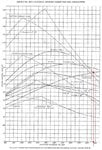At about 358 IAS the P-51 and the FW190 roll about equally, above that speed, the P-51 has the advantage, the FW roll rate is declining sharply, the P-51 roll rate is delcining gradually.
Also, the FW requires the full 50 lbs of stick force to achieve its roll above 350 IAS, where the P-51 could still be rolled with one hand. 50 lbs of stick force is not an easy think in the cramped cockpit of the FW.
You know that is just about contradicted by every single other test carried out wit the two aircraft. The Fw-190 was known for its easy and stable controls at high speeds, on the other hand the P-51 wasnt !
P-51 pilots have actually said that flying P-51 at high speeds was like driving a truck ! Also the P-51 Redlined at 505 mph, and its controls locked up.


